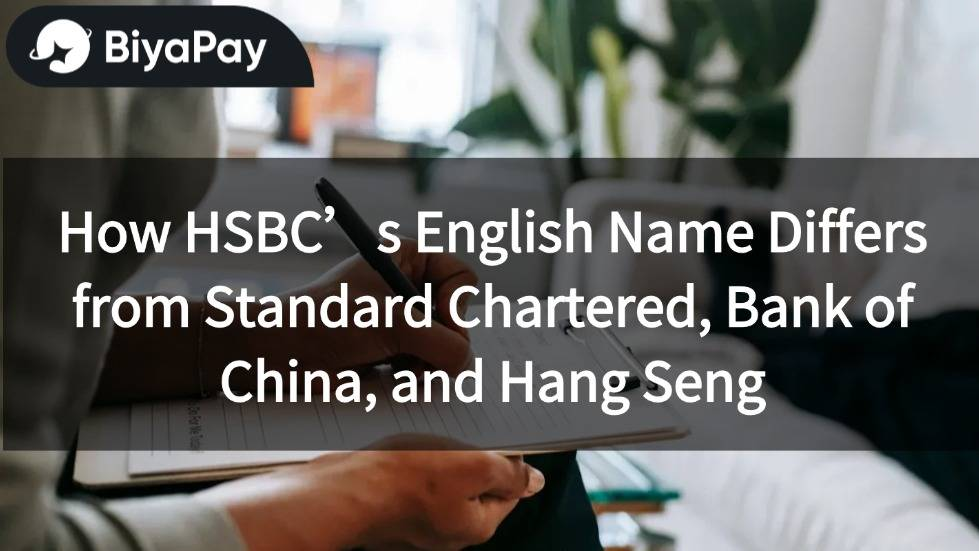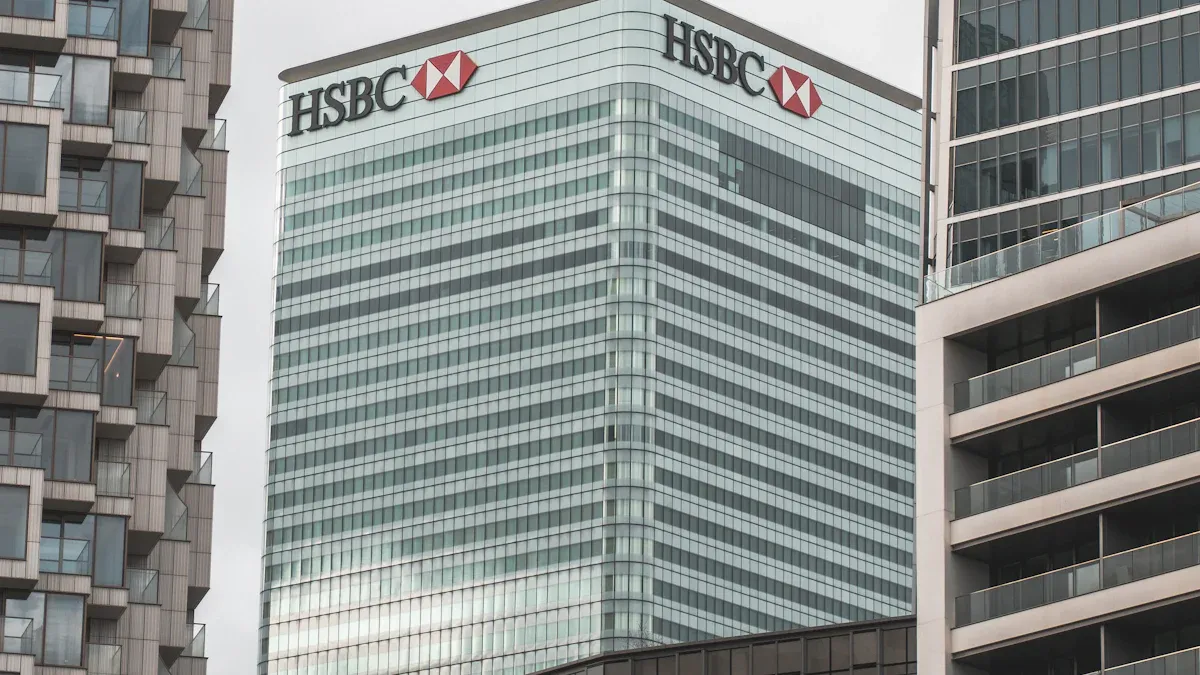- EasyCard
- Trade
- Help
- Announcement
- Academy
- SWIFT Code
- Iban Number
- Referral
- Customer Service
- Blog
- Creator
How HSBC’s English Name Differs from Standard Chartered, Bank of China, and Hang Seng

Image Source: pexels
HSBC’s full English name is highly formal and structurally complete, making it more distinctive compared to other Hong Kong banks. This name includes geographic markers, reflecting its historical background. Many people are familiar with the acronym HSBC, which indicates that HSBC’s English name enjoys extremely high recognition internationally. Why is this name so special? It embodies deep significance in terms of branding and history.
Key Points
- HSBC’s English name is the longest and includes both Hong Kong and Shanghai, showcasing its international history and formal image.
- Standard Chartered and Bank of China Hong Kong include “Hong Kong” in parentheses to emphasize regional identity, while Hang Seng Bank uses only its brand name without geographic markers.
- All four major banks’ English names end with “Limited,” indicating a limited company, ensuring legal transparency and professional trust.
- HSBC’s English name, due to its complete structure and high international recognition, is one of the most representative brands in the global financial market.
- Bank names not only reflect historical backgrounds but also influence brand image and market positioning, helping customers understand the bank’s story and values.
Banks’ Full English Names
HSBC English Name
HSBC’s full English name is “The Hongkong and Shanghai Banking Corporation Limited.” This name is very structurally complete, including two city names: “Hongkong” and “Shanghai.” This reflects HSBC’s origins in Hong Kong and Shanghai and emphasizes its international background. The “Limited” in the name indicates that the company is a limited company. This naming approach is highly formal, highlighting the bank’s history and geographic markers. Many international clients can recognize HSBC’s unique position from this name.
Standard Chartered English Name
Standard Chartered’s full English name is “Standard Chartered Bank (Hong Kong) Limited.” The “Standard Chartered” in the name is the brand name, not directly indicating geographic origins. The “Hong Kong” in parentheses specifies its Hong Kong branch. The final “Limited” similarly indicates a limited company. This naming approach combines brand and region, making it easy to identify its operations in Hong Kong.
Bank of China Hong Kong English Name
Bank of China Hong Kong’s full English name is “Bank of China (Hong Kong) Limited.” The name begins with “Bank of China,” directly emphasizing its Chinese background. The “Hong Kong” in parentheses indicates this is the Hong Kong branch. This naming approach is simple and clear, allowing clients to immediately recognize the bank’s parent company and region.
Hang Seng Bank English Name
Hang Seng Bank’s full English name is “Hang Seng Bank Limited.” This name focuses on the “Hang Seng” brand, without geographic markers. The “Limited” at the end similarly indicates the company’s nature. This naming approach emphasizes brand image, making it easy to remember.
Tip: HSBC’s English name is not only the longest but also includes two city names, which is very rare among Hong Kong banks.
Name Structure Comparison

Image Source: unsplash
Geographic Markers
The English names of major Hong Kong banks differ in their use of geographic markers. HSBC’s English name, “The Hongkong and Shanghai Banking Corporation Limited,” directly includes “Hongkong” and “Shanghai,” a practice very rare among Hong Kong banks. This not only reflects the bank’s origins but also showcases its international perspective. Standard Chartered and Bank of China Hong Kong include “Hong Kong” in parentheses, making their operational region immediately clear. Hang Seng Bank, however, has no geographic markers, emphasizing the brand itself. Historically, geographic markers are closely tied to institutional development. For example, Taiwan’s Buddhist temples’ geographic information system integrates historical documents, helping researchers trace developmental trajectories. This illustrates the significant historical and research value of geographic markers in names.
Brand Naming
In terms of brand naming, each bank employs different strategies. HSBC’s English name combines geographic markers with its brand, creating a unique identity. Standard Chartered uses “Standard Chartered” as its brand, emphasizing the image of an international financial group. Bank of China Hong Kong highlights its Chinese background with “Bank of China,” making the parent company easily recognizable to clients. Hang Seng Bank opts for “Hang Seng” as its brand name, concise and impactful, easy to remember. These naming approaches reflect each bank’s focus on brand image and varying market positioning.
Company Nature
The company nature is also clearly indicated in the English names. All four major banks’ names end with “Limited,” signifying a limited company. This practice complies with Hong Kong company law, allowing clients to clearly understand the bank’s legal status. The completeness and formality of HSBC’s English name further reinforce its professional image. While other banks have shorter names, they similarly adhere to international standards, ensuring transparency and trust.
Differences Between HSBC’s English Name and Other Banks

Image Source: unsplash
Formality
HSBC’s English name stands out in terms of formality. The full name, “The Hongkong and Shanghai Banking Corporation Limited,” is rigorously structured, encompassing geographic markers, company nature, and brand elements. This name is longer and more comprehensive than those of other Hong Kong banks. Standard Chartered’s English name, “Standard Chartered Bank (Hong Kong) Limited,” and Bank of China Hong Kong’s, “Bank of China (Hong Kong) Limited,” include regional markers but have simpler brand names. Hang Seng Bank’s English name, “Hang Seng Bank Limited,” lacks geographic markers, focusing solely on the brand. The formality of HSBC’s English name is not only evident in its length but also reflects its emphasis on historical legacy and corporate image.
Fun Fact: A formal bank name helps enhance a professional image, making it easier for clients to trust the bank’s services and management.
International Recognition
HSBC’s English name also has a clear advantage in international recognition. The inclusion of “Hongkong” and “Shanghai” immediately signals its Asian origins while highlighting its international background. Global clients widely recognize the HSBC acronym. HSBC has become a well-known brand in the international financial sector, easily identifiable by clients in Europe, the Americas, or Asia. In comparison, Standard Chartered and Bank of China Hong Kong’s English names, while clear, have relatively limited brand influence in international markets. Hang Seng Bank primarily serves the Hong Kong local market, with lower international recognition.
The table below briefly compares the international recognition of the four banks’ English names:
| Bank Name | International Recognition | Primary Markets |
|---|---|---|
| The Hongkong and Shanghai Banking Corporation Limited (HSBC) | Extremely High | Global |
| Standard Chartered Bank (Hong Kong) Limited | High | Asia, UK, etc. |
| Bank of China (Hong Kong) Limited | Medium | China, Hong Kong, Overseas |
| Hang Seng Bank Limited | Low | Hong Kong, Parts of Asia |
Tip: The HSBC acronym has become a global symbol in the financial industry, with many international businesses and individual clients prioritizing HSBC’s English name as a partner for cross-border financial collaboration.
The formality and international recognition of HSBC’s English name make it stand out in Hong Kong’s banking sector. This uniqueness is not only reflected in the name itself but also in its brand image and market positioning.
Significance of the Differences
Historical Background
The English names of major Hong Kong banks each have their historical roots. HSBC’s English name, “The Hongkong and Shanghai Banking Corporation Limited,” directly references two cities, reflecting the bank’s early development in Hong Kong and Shanghai. This naming approach makes it easy to associate with the bank’s international starting point. Standard Chartered’s name originates from the merger of two British banks, with the brand name emphasizing the history of an international financial group. Bank of China Hong Kong’s name highlights its Chinese background, indicating its role as a branch of Bank of China in Hong Kong. Hang Seng Bank’s name focuses on the brand, without geographic markers, showcasing the independent development of a local bank.
Many academic studies, through surveys and statistical analysis, have found that geographic markers and brand elements in bank names can influence customers’ perceptions of a bank’s history and positioning. These studies often use methods like KMO values and Bartlett’s test of sphericity to ensure the rigor of their findings.
Brand Image
Bank names not only reflect history but also directly influence brand image. HSBC’s English name, with its complete structure and clear international character, creates an impression of professionalism and trust among customers. Standard Chartered and Bank of China Hong Kong reinforce their positions in Asian and Chinese markets through their brand names and regional markers. Hang Seng Bank, with its concise brand name, cultivates a localized, approachable image.
- Market research reports indicate that banks can use structural equation modeling, brand perception scales, and customer satisfaction indices to quantify differences in brand image.
- Studies have found a clear connection between name structure and brand image. Brand association networks and brand equity management theories further explain how name differences affect customers’ overall evaluations of banks.
These analyses demonstrate that differences in bank names are not only a reflection of history but also a critical basis for brand image and market positioning. The uniqueness of HSBC’s English name gives it a competitive edge in international markets.
HSBC’s English name is structurally complete, includes geographic markers, and showcases an international history. Standard Chartered, Bank of China Hong Kong, and Hang Seng Bank each have distinct naming approaches. These differences reflect the banks’ brand positioning and market image. Readers can understand the stories and development of Hong Kong banks through the details of their names.
A name is not just a label; it is a microcosm of a bank’s history and brand.
FAQ
Why is HSBC’s English name particularly long?
HSBC’s English name includes two cities, reflecting its historical origins. The name’s complete structure emphasizes internationalization and formality.
What does the HSBC acronym stand for?
HSBC stands for “The Hongkong and Shanghai Banking Corporation.” This acronym enjoys extremely high recognition in global financial markets.
Does Standard Chartered’s English name include geographic markers?
Standard Chartered’s English name includes “Hong Kong” in parentheses, indicating its Hong Kong branch identity.
What is the difference between Bank of China Hong Kong and Hang Seng Bank’s English names?
Bank of China Hong Kong’s name highlights its Chinese background, with “Hong Kong” in parentheses. Hang Seng Bank’s name uses only the brand, without geographic markers.
What is the common feature of the four major banks’ English names in terms of company nature?
| Bank Name Ending | Company Nature |
|---|---|
| Limited | Limited Company |
All bank names end with “Limited,” indicating they are limited companies.
In 2025, HSBC’s English name, “The Hongkong and Shanghai Banking Corporation Limited,” stands out with its comprehensive structure and international heritage, contrasting with Standard Chartered, Bank of China (Hong Kong), and Hang Seng. BiyaPay offers a seamless financial solution, enabling Hong Kong and U.S. stock trading with a single account and a wealth management product offering up to 5.48% annualized return, accessible anytime with flexible withdrawals—no additional overseas accounts needed. Start now at BiyaPay!
BiyaPay supports real-time conversions across multiple fiat and digital currencies with transparent rate queries, minimizing costs with remittance fees as low as 0.5%. Regulated by international financial authorities, it ensures secure, reliable transactions, complementing the professional services of banks like HSBC for efficient wealth management. Visit BiyaPay today to seize financial opportunities!
*This article is provided for general information purposes and does not constitute legal, tax or other professional advice from BiyaPay or its subsidiaries and its affiliates, and it is not intended as a substitute for obtaining advice from a financial advisor or any other professional.
We make no representations, warranties or warranties, express or implied, as to the accuracy, completeness or timeliness of the contents of this publication.




Contact Us
Company and Team
BiyaPay Products
Customer Services
is a broker-dealer registered with the U.S. Securities and Exchange Commission (SEC) (No.: 802-127417), member of the Financial Industry Regulatory Authority (FINRA) (CRD: 325027), member of the Securities Investor Protection Corporation (SIPC), and regulated by FINRA and SEC.
registered with the US Financial Crimes Enforcement Network (FinCEN), as a Money Services Business (MSB), registration number: 31000218637349, and regulated by FinCEN.
registered as Financial Service Provider (FSP number: FSP1007221) in New Zealand, and is a member of the Financial Dispute Resolution Scheme, a New Zealand independent dispute resolution service provider.




















